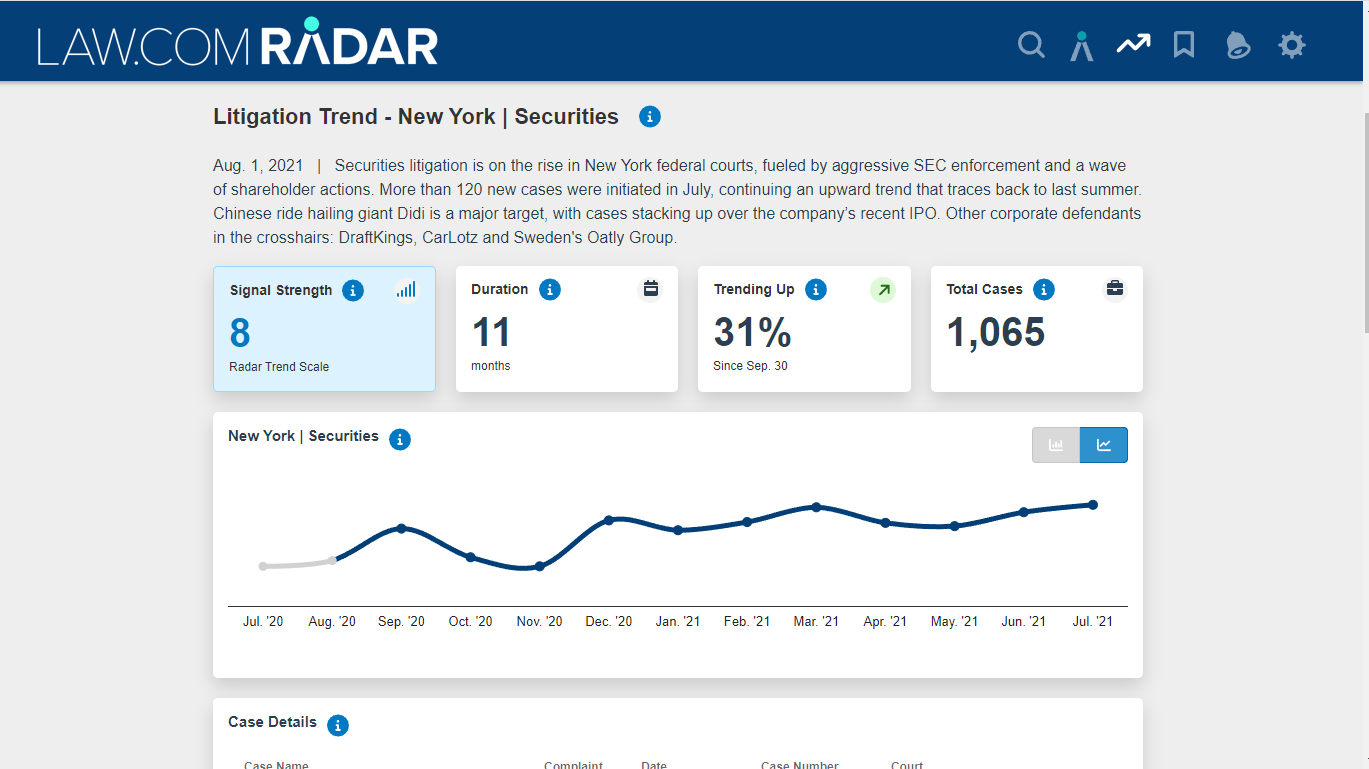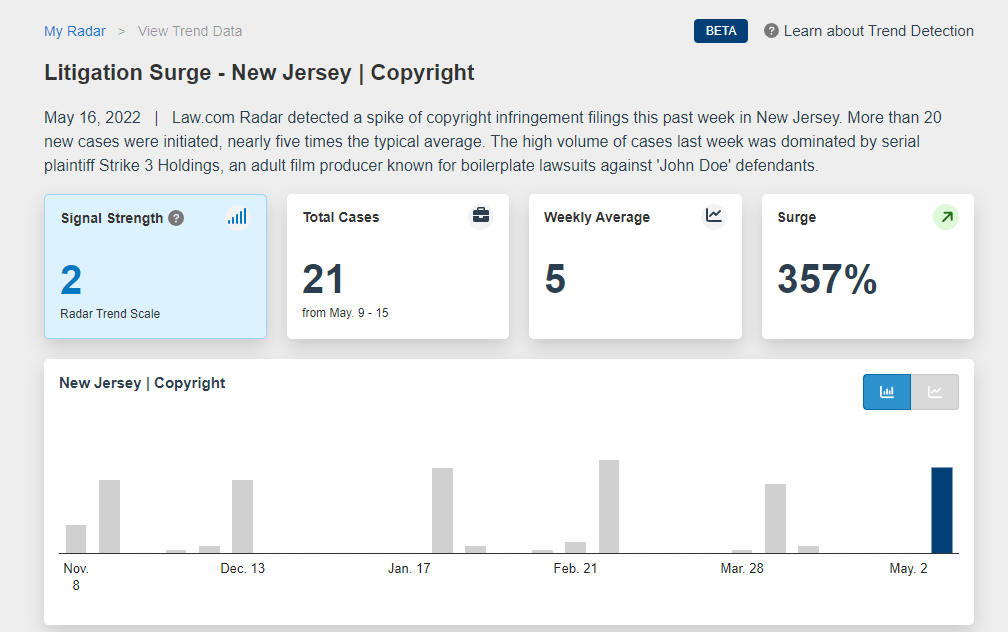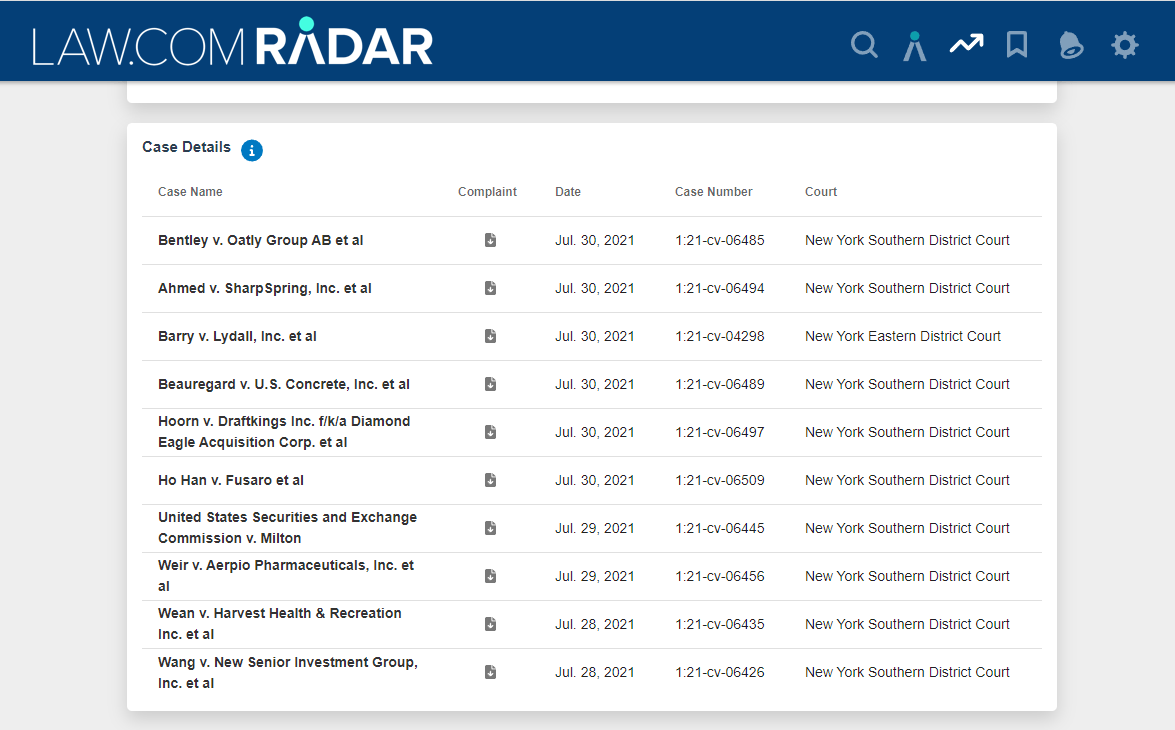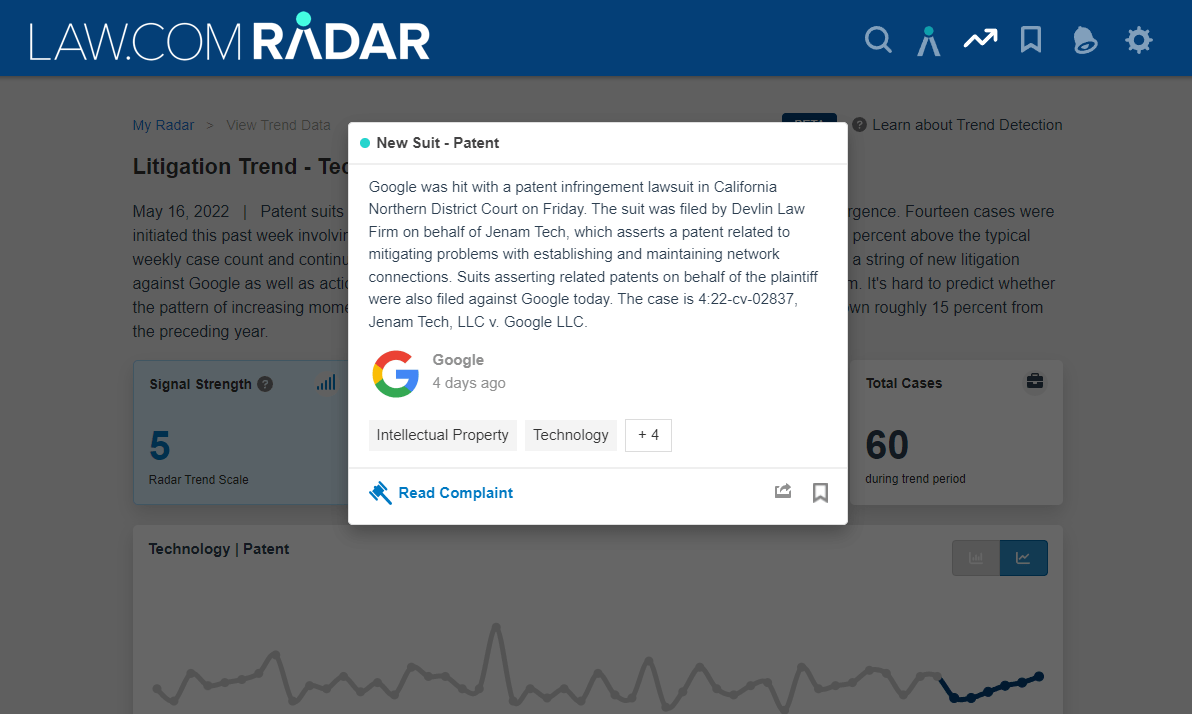Two years ago, the legal and business news company ALM launched Law.com Radar, a service of the legal news site Law.com that delivers custom-tailored news drawn from court dockets, with a unique twist — its news summaries are generated algorithmically, rather than by human editors. It later added transactional news to the mix.
Now, Law.com Radar is taking its algorithm even further with the unveiling of a live-beta feature, Trend Detection, that identifies trends and patterns in the ocean of federal court litigation data, revealing where cases are surging or ebbing as they impact particular practice areas, industries, or even a single client.
“ALM’s Trend Detection lets you see shifts and patterns in case filings, often invisible to the human eye,” explains a page introducing the feature. “Using advanced data analysis and expert curation, your team now has a tool to identify opportunities and develop the right strategy when it counts.”
![]() The feature is currently available to all paid subscribers to Law.com Radar, who can find it by clicking the arrow icon that now appears in the navigation menu.
The feature is currently available to all paid subscribers to Law.com Radar, who can find it by clicking the arrow icon that now appears in the navigation menu.
Identifying Spikes and Trends
Recently, Vanessa Blum, newsroom innovation director at ALM, and Ben Hancock, newsroom data engineer, gave me a demonstration and briefing on Trend Detection. They also provided me with a trial subscription.
“The idea with Trend Detection is that, in the backend of Radar, we’re using automation to process litigation data and generate immediate updates on newly filed litigation,” Blum told me. “What we’ve been wanting to do, and working on for the past year, is developing a mechanism to analyze the data at a higher level and identify shifts and trends within that data.”
What Trend Detection does, she said, is identify spikes in activity and unusual levels of activity in particular practice areas or industries, or in litigation against a specific company. It also looks for trends in the form of sustained upward or downward shifts in activity.
As it detects these shifts and trends, Trend Direction presents them in cards that summarize the activity and allow the reader to drill down into more detail.
The reporting of the trend is created both algorithmically and editorially, Blum said. It is first algorithmically created based on the data, the statistics and the definitions it uses. It is then reviewed and refined by human editors, who can review the underlying cases and docket information and provide added context and insight.
A key distinguishing factor about Trend Detection, Hancock said, is that it is not a research tool in which editors suspect a trend and then seek to confirm it. Rather, it is detecting trends algorithmically to surface ones that might not otherwise be seen but that are of interest to Radar’s readers.
The system is further calibrated to identify trends only when they reach a certain level of intensity, consistency and confidence level. “We’ve calibrated the system to require a certain level of intensity, a certain level of confidence, before we would surface it,” Blum said. “And then we also have editorial review.”
Customized News Feeds
For subscribers, the trends they see are filtered according to the preferences they have set. As I have previously explained, a central feature of Law.com Radar is that users are able to customize their news feeds by industries, practice areas and geographic regions, as well as for news related to specific companies and law firms.
The card for a specific trend provides an overview of its duration, the degree of change, and the total cases involved, as well as a “Signal Strength” score, which reflects the intensity, impact and business significance of the trend on a scale of 1-10.
The card also lists the cases that underlie the trend. Clicking on any case name brings up a modal showing a summary of the case and a link to court documents.
Automating A Manual Process
So what is the value of this service to subscribers? Blum and Hancock say it is in adding a layer of efficiency to an activity many law firms already routinely perform — that of litigation surveillance and monitoring — but that they currently do using mostly manual methods.
Whether through their research departments, business development teams, or by individual litigators, law firms are watching the flow of cases for patterns, and then making business decisions or providing client advice based on that information, Blum said.
“This is an effort to automate some of that process and deliver that finding, that discovery, directly to the end user,” she said.
Hancock said Radar’s regular algorithmic reporting of litigation news was already beginning to reveal patterns, but in a drip fashion that only close followers, such as ALM’s own editors, would perceive.
But for readers who might think, “It seems like I’ve seen several of these cases recently,” Trend Detection eliminates the need for them to go back through stories and try to verify that on their own. “The idea is really to surface that and push that insight to the user,” he said.
While Trend Detection identifies trends in existing practice areas, I asked Blum and Hancock if it could identify emerging potential new areas of practice.
It is not there yet, Blum said, but she is hopeful that they can eventually build that into the product. In the meantime, ALM’s editors are watching for such trends, and then adding them into the product as they become significant. One example: cryptocurrency was added to Radar six months ago as editors identified that as a focus of litigation.
And while Trend Detection currently works only with litigation data, Blum says it will also eventually be used to identify trends in deal data and possibly in the law firm business and financial data that ALM collects.
Full access to Law.com Radar, including the new Trend Detection feature, is available through either a Law.com subscription, which costs $124.99 a month when billed annually, or as a standalone subscription for $19.99 a month. ALM also offers a free version of Law.com Radar, but it lacks all the features of the premium version and does not include Trend Detection.
ALM launched Law.com Radar — originally under the name Legal Radar — in February 2020. In November 2020, it rolled out a new version, renamed Law.com Radar, that added news of corporate transactions and introduced the paid subscriptions.
 Robert Ambrogi Blog
Robert Ambrogi Blog


